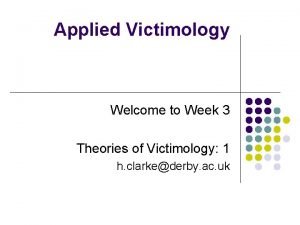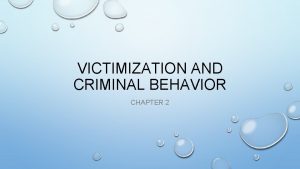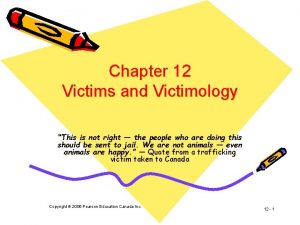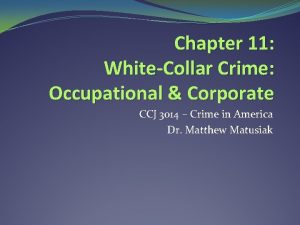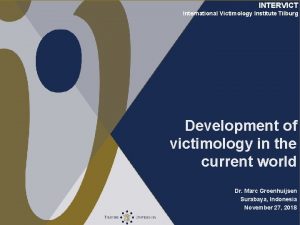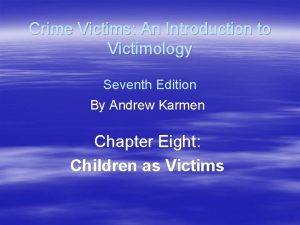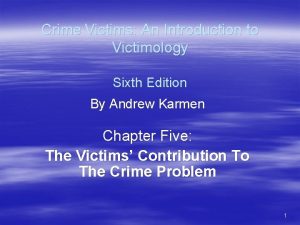Chapter 4 What is Victimology CCJ 3014 Crime













- Slides: 13

Chapter 4: What is Victimology? CCJ 3014 – Crime in America Dr. Matthew Matusiak

Introduction �Victimology first identified by Benjamin Mendelsohn (1947) �Focus of Study �Causes of victimization �Consequences of victimization �Criminal Justice System responses to victimization �Societal responses to victimization

Nature of Victimization � 2008 UCR Reports � 1, 382, 012 violent crimes � 9, 767, 915 property crimes � 2010 Victim Reports � 3. 8 million violent victimizations � 14. 8 million property victimizations �Typical Victimization & Victim �Gender �Race & Ethnicity �Age �Household Characteristics

Costs of Victimization �Economic Costs �Direct property loss �Medical care �Mental health care �Losses in productivity �Pain, suffering, & lost quality of life �System Costs �Criminal Justice System �Insurance �U. S. Federal spending

Costs of Victimization �Mental Health Consequences & Costs �Common affective responses � Depression � Reductions in self-esteem � Anxiety �Post-traumatic stress disorder (PTSD) � Criteria � 25% of crime victims vs. 9% of non-victims experience PTSD �Characterological self-blame �Behavioral self-blame �Learned helplessness

Costs of Victimization �Mental Health Consequences & Costs �Fear of Crime � Avoidance behavior � Defensive or protective behaviors �Recurring Victimization � Recurring � Repeat � Revictimization � Characteristics � Explanations � Risk Heterogeneity � State Dependence

Theories of Victimization �Role of the Victim in Crime �Victim Precipitation �Victim Facilitation �Victim Provocation �Hans von Hentig � Considered criminal-victim dyads �Benjamin Mendelsohn � Recognized that many victims & offenders were known to each other � Victim classification

Theories of Victimization �Role of the Victim in Crime �Stephen Schafer � Used social characteristics & behavior to categorize victims by responsibility � Victim classification �Marvin Wolfgang � Philadelphia homicide study (1948 -1952) � 26% of homicides were victim precipitated �Menachem Amir � Research similar to methods of Wolfgang related to rape � Highly controversial due to its perceived victim blaming

Theories of Victimization �Routine Activities Theory �Cohen & Felson (1979) �Motivated offender �Suitable target �Capable guardian �Lifestyles Theory �Hindelang, Gottfredson, & Garafalo (1978) �Certain lifestyles & behaviors place people in situations were victimization is likely to occur �Principle of homogamy

Theories of Victimization �Structural Causes of Victimization �Hot spots �Family structure �Structural density �Residential mobility �Community disadvantage

Caring for the Victim �Victims’ Rights �Began to be recognized in the 1970 s �All states recognize victims’ rights but to differing degrees �Victim Remedies & Services �Victim compensation � Victim of Crime Act of 1984 � Eligibility � State funding caps � $10, 000 - $25, 000

Caring for the Victims �Victim/Witness Assistance Programs �Inform victims of court procedure and their rights �Notify them about court dates and changes in schedules �Seek to increase participation in the process �Family Justice Centers �Locate all services in one place �Victim-Offender Mediation Programs �Allow dialogue between victim and offender �Voluntary participation by the victim �Victims tend to have higher levels of satisfaction with the system

Chapter 4: What is Victimology? CCJ 3014 – Crime in America Dr. Matthew Matusiak








